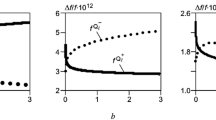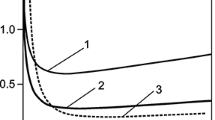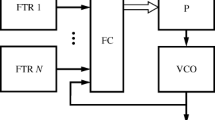A survey of the results of investigations of the frequency instability of output signals of the hydrogen frequency standard is presented. We analyze the causes of development of instability in the measurement range greater than 1000 sec. The influence of the ambient temperature and geomagnetic field is investigated. The methods used to compensate the frequency drift with the help of periodic corrections are described.




Similar content being viewed by others
References
C. Audoin and J. Vanier, The Quantum Physics of Atomic Frequency Standards, IOP Publ., Bristol–Philadelphia (1989), Vol. 2.
A. V. Gorokhov and V. A. Mikhailov, “Relaxation of a two-level system interacting with external stochastic fields,” Teor. Fiz., No. 1, 54–62 (2000).
V. I. Vasil’ev, V. V. Gavrilov, and S. A. Kozlov, “Hydrogen frequency and time standards,” in: Russian Radioelectronic Technologies, Moscow (2012), pp. 97–109.
V. I. Vasil’ev, “Investigation of the limiting short-term frequency instability of the output signal of a passive hydrogen frequency standard,” Izmer. Tekhn., No. 9, 25–29 (2016).
R. F. Vessot, “The atomic hydrogen maser oscillator,” Metrologia, 42, S80–S89 (2005).
V. I. Vasil’ev, “A physical model of the systematic variation of the frequency of the output signal of hydrogen frequency and time standards,” Izmer. Tekhn., No. 2, 31–34 (2014).
V. I. Vasil’ev, V. V. Gavrilov, A. G. Gorelov, and V. A. Logachev, “Compensation of the frequency drift of the output signal of the Ch1-75B hydrogen frequency standard,” in: Proc. 7th Int. Symp. Metrology of Time and Space, VNIIFTRI, Mendeleevo (2014), pp. 242–246.
V. I. Vasil’ev, “Temperature sensitivity of a passive hydrogen frequency and time standard caused by the influence of hydrogen discriminator,” Radioizmer. Elektron., Iss. 15, 51–55 (2009).
M. A. Humphrey, D. F. Phillips, and R. L. Walsworth, “Double resonance frequency shift in a hydrogen maser,” Phys. Rev. A, 62, Art. No. 063405 (2000).
G. M. Jenkins and D. Watts, Spectral Analysis and Its Application, Holden-Day, San-Francisco (1968).
A. A. Lyubushin, Analysis of the Data of Systems of Geophysical and Ecological Monitoring, Nauka, Moscow (2007).
V. V. Vakhnina, A. A. Kuvshinov, and V. A. Kuznetsov, “Reduction of risks of the development of accidents in electric power-supply systems during geomagnetic storms,” Geliogeofiz. Issled., Iss. 5, 115–123 (2013).
Author information
Authors and Affiliations
Corresponding author
Additional information
Translated from Izmeritel’naya Tekhnika, No. 5, pp. 42–46, May, 2018.
Rights and permissions
About this article
Cite this article
Vasil’ev, V.I. Minimization of the Instability of Hydrogen Frequency Standards in Long Time Intervals. Meas Tech 61, 474–480 (2018). https://doi.org/10.1007/s11018-018-1454-x
Received:
Published:
Issue Date:
DOI: https://doi.org/10.1007/s11018-018-1454-x




